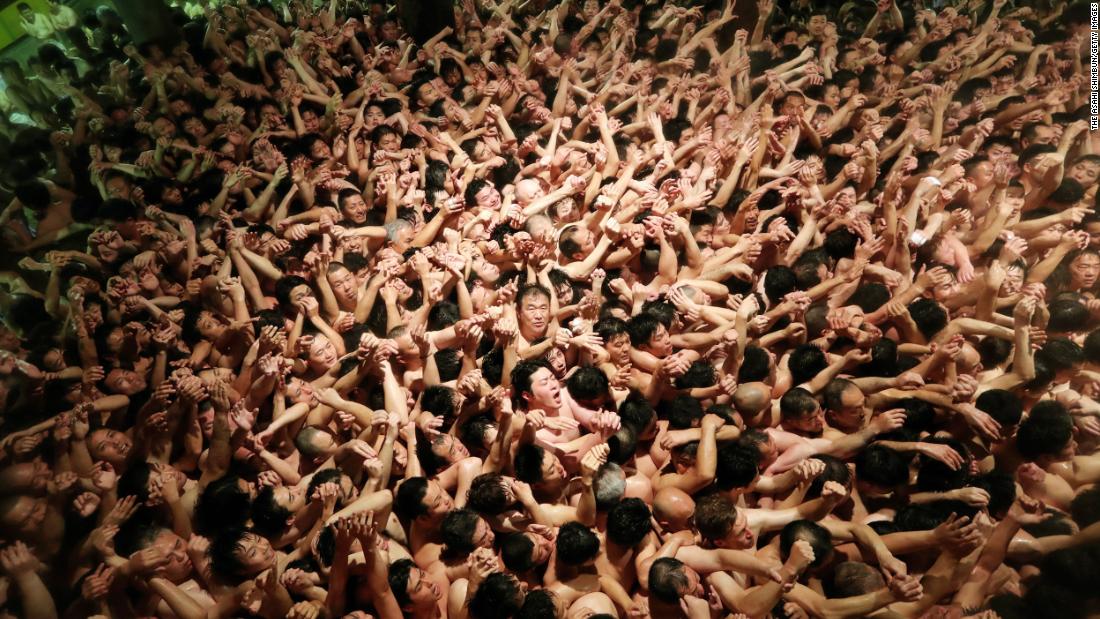Tokyo (CNN) — Thousands braved chilly weather on Saturday to gather at the annual “Naked Festival” in Okayama prefecture in the southern part of Japan’s Honshu island.
The event, called “Hadaka Matsuri” in Japanese, is a wild and raucous festival held every year on the third Saturday of February at the Saidaiji Kannonin Temple, about a 30-minute train ride from Okayama city.
But the 10,000 or so male participants aren’t as naked as the festival’s name suggests.
They sport a minimal amount of clothing; usually a Japanese loincloth called a “fundoshi” and a pair of white socks called “tabi.”
The festival, which celebrates the blessings of a bountiful harvest, prosperity and fertility, starts at around 3:20 p.m local time with a separate event for young boys — aimed at fostering interest in younger generations.
In the evening, the men spend an hour or two running around the temple grounds in preparation and purify themselves with freezing cold water, before cramming themselves into the main temple building.
When the lights go out at 10 p.m., a priest throws 100 bundles of twigs and two lucky 20-centimeter-long shingi sticks into the crowd from a window four meters above.
That’s when the commotion begins.
The 10,000 or so men, packed in like sardines, jostle with each other to get hold of one of the bundles and/or the two sticks. Whoever succeeds is guaranteed a year of good fortune, according to legend.
The shingi are more sought after than the less-coveted twigs, which can be taken home. The whole event lasts around 30 minutes and participants emerge with a few cuts, bruises and sprained joints.

Men in loincloths bathe in cold water to purify their souls as part of the “Hadaka Matsuri” (Naked Festival) at Saidaiji Temple on February 15, 2020 in Okayama, Japan.
The Asahi Shimbun/Getty Images
Something for everyone
The festival evolved from a ritual that started 500 years ago during the Muromachi Period (1338-1573), when villagers competed to grab paper talismans, which were given out by a priest at the Saidaiji Kannonin Temple.
More and more villagers wanted those lucky paper talismans and the ritual grew in size. But they realized that when they went to grab the paper it ripped. Their clothes just got in the way too, so they eventually did away with them and exchanged paper for wood, said Itano.
There are plenty of other festivities to check out for those that don’t feel like stripping down to a loincloth in mid-winter, too.
Before the main Okayama event, there is an afternoon of traditional dances and a performance by a troupe of female drummers. A fireworks show starts at 7 p.m.
At Gofuku-dori, a nearby shopping street, locals open their doors and welcome participants and spectators.
You don’t have to be a local to take part in the main “naked” event. You can either register in advance to buy your loincloth and tabi socks, or buy them on site if you feel like joining in.
Saidaiji Temple 3-8-8 Saidaiji-naka, Higashi-ku Okayama-shi, Okayama-ken 704-8116 Japan
Top photo: Approximately 10,000 men in loincloths try to snatch a lucky wooden stick during the “Naked Festival” at Saidaiji Temple on February 15, 2020 in Okayama, Japan. Credit: Asahi Shimbun via Getty Images
